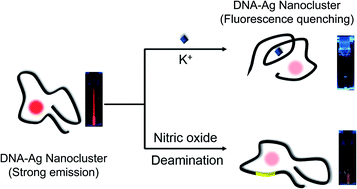DNA-templated silver nanoclusters as label-free, sensitive detection probes for potassium ions and nitric oxide†
Abstract
DNA-templated silver nanoclusters (DNA–AgNCs) have emerged as promising materials for sensing, bio-labelling, and bio-imaging due to their fluorogenic properties. Using the 12 mer DNA with a cytosine-rich sequence, AgCNs have been formed successfully. Herein, we develop two different types of DNA–AgNC systems for the detection of potassium ions (K+) and nitric oxide (NO) by utilizing the structural change of DNA or DNA template transformation. In K+ detection, a thrombin binding aptamer (TBA) was utilized as both the AgNC template and the K+ binding probe. The fluorescence emission of the DNA1–AgNC probe was diminished proportionally to the amount of K+ detected, which transforms the AgNC-adapted structure into G-quadruplex. On the other hand, NO detection has been accomplished by NO-induced deamination of cytosine. The structural change of cytosine to deoxyuridine destabilizes the DNA2–AgNC structure, resulting in quenching of fluorescence intensity. The characteristics of these two highly quantitative detection probes were analysed by UV absorption, fluorescence emission, and transmission electron microscopy (TEM). Each system provides a detection limit of 6.2 μM for K+ and 0.1 μM for NO. We expect that these systems enable the opening of a new horizon for highly sensitive and selective detection systems.

- This article is part of the themed collection: Emerging Investigators

 Please wait while we load your content...
Please wait while we load your content...